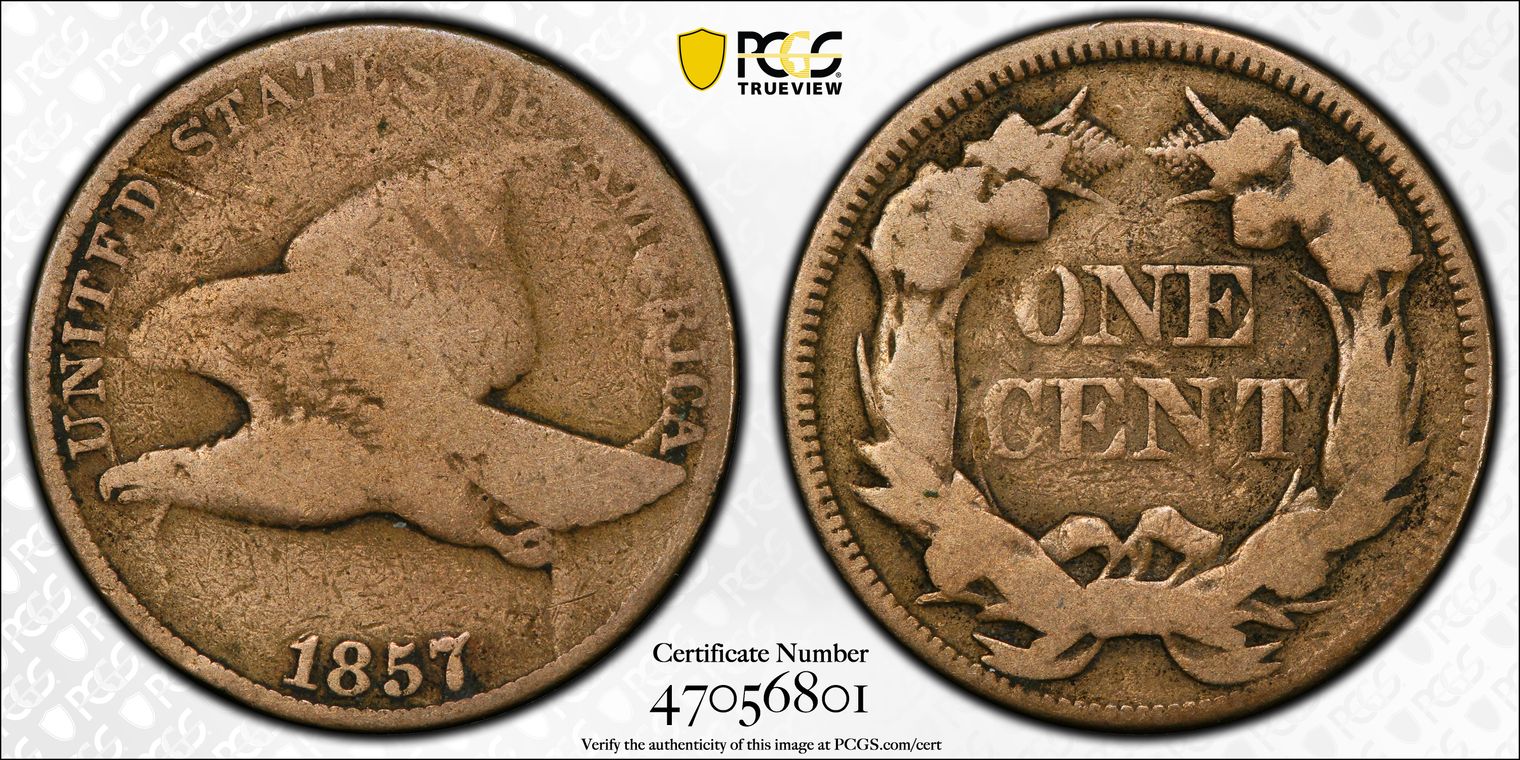1857 1C Obv. Die Clash w/ $20, FS-403 G4 认证号47056801, PCGS号37376
拥有者评论
Eagle Eye Photo Seal
专家评论
Jaime Hernandez
Some believe that there are as many as 60 examples extant for the 1857 Flying Eagle cents with a Clashed $20 Double Eagle obverse design. If this was indeed the case, it would make this a very scarce variety. However, I personally disagree with that figure and I would estimate that less than half of this estimate actually exists!One of the main reasons why I believe this coin exists in much smaller quantities is due to the simple fact that, this variety hardly ever comes up for sale. And when they do come up for sale, it is usually the same exact coin, which makes the coin practically unattainable.
Furthermore, very few coins show up in the population reports for this variety. The population figures should provide a general idea of their scarcity, since the variety itself is fairly transparent, even with the naked eye. Likewise, it would make a lot of sense that most coins or at least many more should have been graded by now, since the coins command a high premium even in the lowest grades and especially graded examples.
As of 2009, PCGS has only graded six examples of this variety in all grades combined. The highest graded example is a PCGS AU58 example. As far as I am aware, there are no mint state coins in existence for this variety and there has never been one reported. Only about a dozen or so coins of this variety have sold at public auction. This includes all graded coins which are attributed and non attributed coins in the holders and even raw coins.
The 1857 Flying Eagle cent with a Clashed $20 Double Eagle variety was produced when an 1857 flying eagle cent obverse die and a $20 Double eagle obverse die collided with one another, when there was no coin planchet placed in-between the two dies. Therefore, each die left part of the design impression on the opposing die. Keep in mind, on coin dies the highest portion of the dies are the fields, since the coin die designs are always the opposite of the actual coins. Because of this, the clash marks on the 1857 Flying Eagle cent with a Clashed $20 Double eagle are only visible in the fields of the coin, and not on the design of the coin.
It is unknown as to why there was a Flying eagle obverse die and a $20 Double eagle obverse die in the same press and at the same time in the first place. Obviously, the Mint had less stringent policies in 1857 as they do today when minting coins. However, what is even more compelling is the fact that both dies were struck together, with no coin planchets placed in-between the two dies. Furthermore, there are no mule coins known as being struck from this pair of dies.
To make matters more controversial, there are also two additional 1857 flying eagle cents known which were also clashed with different denominations. The second variety of an 1857 flying eagle cent was clashed with a seated Liberty quarter. The third 1857 flying eagle cent variety was clashed with a seated Liberty half dollar. The 1857 Flying Eagle Cent Clashed with $20 Gold Double eagle is unquestionably the scarcest of the three clashed die varieties for the 1857 flying eagle cents.
For the 1857 Flying Eagle cent with a Clashed $20 Double Eagle variety, the obverse of the 1857 Flying Eagle cent displays slight traces of a $20 double eagle design.
The tip of Liberty’s nose from the $20 double eagle can be seen towards the top of the M in AMERICA on the 1857 Flying eagle cent.
The upper portion of Liberty’s nose from the $20 double eagle extends to the top of the A of AMERICA and right above the F in OF on the 1857 Flying eagle cent's obverse.
Liberty’s lips from the $20 double eagle can also be noticed on the back leg of the R in AMERICA on the 1857 Flying eagle cent's obverse.
Liberty’s chin from the $20 double eagle can be seen below the C and A of AMERICA on the 1857 Flying eagle cent's obverse.
The front part of liberty’s neck from the $20 double eagle can be seen running down vertically through the eagle’s talons on the 1857 Flying eagle cent's obverse.
Liberty’s hair strands from the $20 double eagle can be seen running down vertically below the eagle’s beak on the 1857 Flying eagle cent's obverse.
Did a mint employee confuse the dies three different times? If so, why did he turn the press on when there were no coin planchets three different times? How come there are no mule coins or if they were test strikes, where are they? What is also mysterious is that there are Indian cents from around the same time known as being struck in completely different metal alloys. For example, there are three known 1900 Indian cents which were struck in $2.50 gold planchets and also other dates in the Indian cent series.
There are so many unanswered questions for the varieties of 1857 which we will probably never know the answers too. However, this coin has it all, mystery, scarcity and history, which are all the necessary components of being a tremendously desirable coin.
PCGS #
37376
设计师
James Barton Longacre
边缘
Plain
直径
19.00 毫米
重量
4.70 克
铸币数量
17450000
金属成分
88% Copper, 12% Nickel
更高评级数量
35
评级较低的钱币数量
5
地区
The United States of America
价格指南
PCGS 数量报告
拍卖 - PCGS 评级的
拍卖 - NGC 评级的
状况普查 了解更多
 #1 AU58 PCGS grade
#1 AU58 PCGS grade
Larry Steve Collection - American Numismatic Rarities 7/2003:137 - Tom & Jean Fore Collection - Heritage 1/2016:4445, $30,550 |
| #2 XF45 PCGS grade |
| #3 XF40 PCGS grade |
| #4 VF35 PCGS grade |
| #5 VF30 PCGS grade |




















